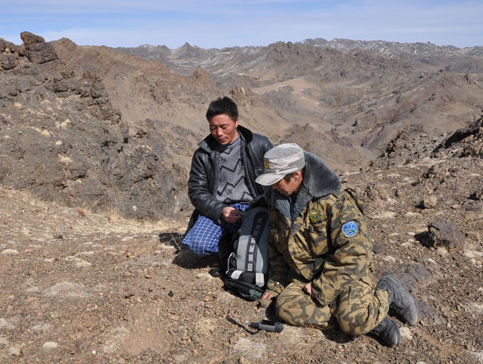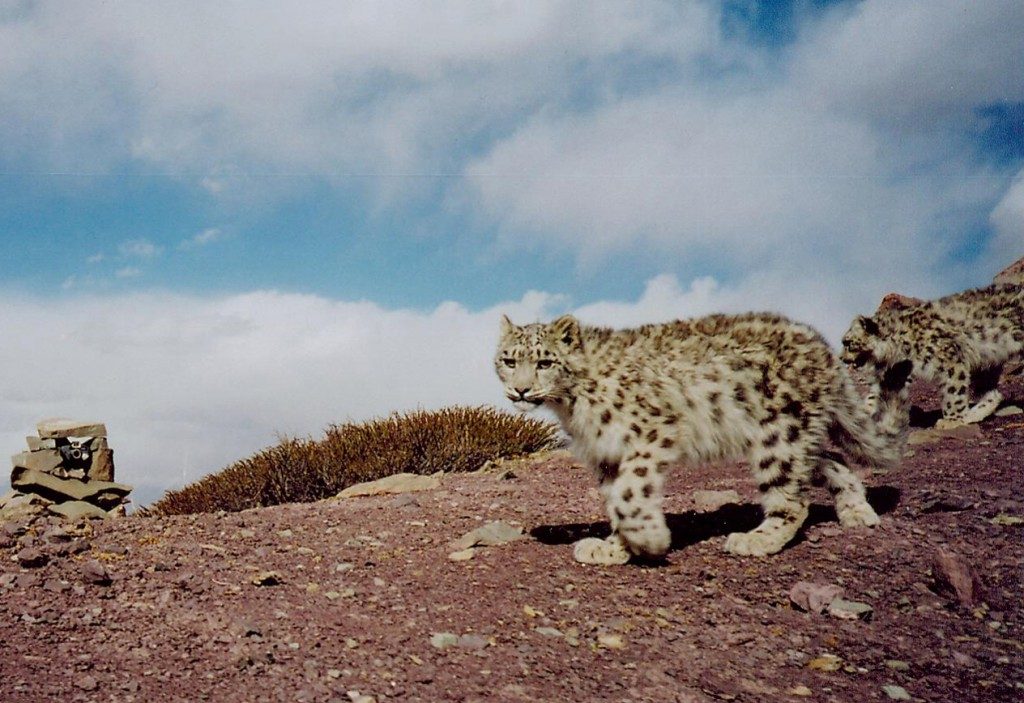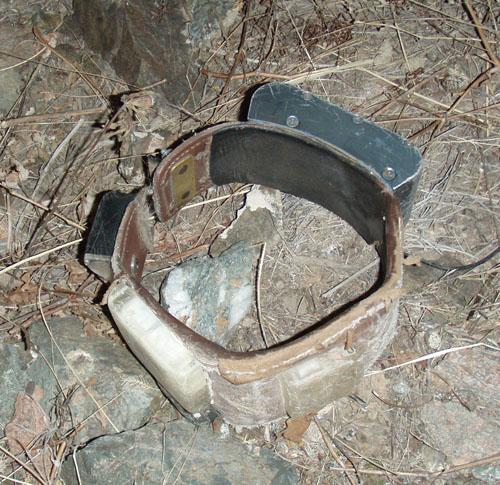
The main purpose of biodiversity conservation is to ensure stable and healthy ecosystems by preserving the variety of life within them. To do this, it’s necessary to gain an understanding of the different species within the ecosystem, including humans, and how they work together to maintain the ecological balance.
Conservationists study and monitor threatened predators like the snow leopard and the other species who live within their range and then interpret the data collected and use it to direct conservation measures.
Excerpt: Shavaun Mara Kidd and Bjorn Persson, Searching for the Snow Leopard, Guardian of the High Mountains, (New York: Arcade Publishing, 2020), 135.
In this method, biologists count the sign left along the cat’s travel routes. Fortunately, snow leopards tend to leave relatively abundant sign as they move about their home ranges. But you need to know where to look!
Advantages:
- Non-invasive, rapid, not requiring special equipment
- Relatively simple application following basic training
- Widely use by field personnel
- Results immediately available in the field.
Disadvantages:
- Sign is destroyed by livestock, rain, or may be covered by snow
- Difficulty in converting sign abundance to number of snow leopards
The Snow Leopard Conservancy joined forces with CyberTracker in 2006 to develop a simple icon-based system using a hand-held Personal Digital Assistant device (PDA) and software application for enabling local people to monitor and record information on snow leopards, their prey and habitat.
CyberTracker is routinely used by park rangers to document anti-poaching patrols and improve the effectiveness of wildlife law enforcement patrols and site-based conservation activities across the globe, as exemplified by the SMART standard protocol: http://smartconservationtools.org/
Tracking Snow Leopards: Biologists and even villagers in Ladakh, Northern India, and Mustang, Nepal have found it easy to record field observations by selecting icons, pictures, or symbols (with minimal text), then storing the resulting geographically referenced observations for future download.
Challenges:
-
Slow, unreliable GPS chips that experienced some difficulty locking onto satellites, especially in rugged Himalayan mountain environment
-
Extremely limited battery life and unstable memory capacity of the available PDA’s like PalmPilot
-
Some users required special trainings, including periodic refresher courses and select incentives
Solutions:
- Handheld field devices have evolved significantly in terms of capability and functionality, along with internet access becoming more available in the remote snow leopard range.
- In 2014, Holger Rohl, a registered trainer of CyberTracker based in Germany helped transfer SLC’s Snow Leopard app to the more user-friendly Android platform.
- It can now be deployed on Smartphones and tablets; all of which have much more efficient GPS chips and long-lived batteries, along with other attributes making data collection and storage easer.
- In addition, many other Apps and customized wildlife observation templates are now also available, including iNature or ESRI’s Survey 123 which is being used by the Land of the Snow Leopard Network users in Central Asia.
The Snow Leopard Conservancy pioneered the use of non-invasive, remotely-triggered camera “traps” for photographically “capturing” this seldom-seen carnivore. Ullas Karanth of the Wildlife Conservation Society was the first to use remote cameras to census tigers in India. But no one had attempted this technique under the harsh conditions of Himalayan winters or on a species whose elusiveness is so legendary.
Cameras are set where a snow leopard would be expected to visit; the camera automatically takes the image of any warm-bodied animal that happens to pass by. Some cameras use white or incandescent flash at night while others record pictures using only infra-red light which is invisible to many animals. The latest devices operate in sub-zero temperatures and can be left unattended for weeks or even months at a time while the supervising scientist is miles away. Camera traps enable researchers and conservationists to accurately establish population size, identify resident cats or track specific individuals over extended periods of time within the camera-trapped area.
Advantages:
- Generally non-invasive
- Provides direct counts of the visiting snow leopards
- Allows for statistically valid population estimates and reliable monitoring of resident snow leopards over time
Disadvantages:
- Equipment is costly and quickly outdated
- Cameras are vulnerable to theft or damage
- Requires special expertise and is labor- and time-intensive to set up a proper trail-cam survey
The status and distribution of snow leopards are unknown in many parts of Central Asia. Likewise, information on the genetic diverity and population structure of this cat is not available. Yet these issues are critical for developing effective conservation initiatives and assessing the long-term success of various programs designed to protect snow leopards. Because snow leopards are difficult to capture, one of the most effective techniques for sampling their wild populations is by collecting feces (scat). When this is combined with genetic analysis, much information on their populations can be obtained. This approach is referred to as noninvasive genetics.
Advantages:
- Non-invasive
- Easy-to-conduct field surveys allowing for large areas to be surveyed in significantly less time than it takes to camera-trap snow leopards
- Generates detailed information on actual number of snow leopards, their gender, maternally inherited relatedness, movement patterns, and other aspects of population structure
Disadvantages:
- Genetic material deteriorates with age; fresh scats yield the best results
- Requires special laboratory facilities adhering to rigorous standards, and well-trained personnel
- Results are not available while in the field
Habitat or patch occupancy models document presence/absence and relative abundance of wildlife species. Establishing the absence of a species in a particular area is complicated— is it really absent or did the observer simply fail to find sign, when in fact the animal was in the area during the survey?
Occupancy models involve searches of sample areas (grids or polygons) of designated size over a relatively short time interval (e.g., 2-5 consecutive days) to determine if the area is being used by snow leopards. The researcher tallies the proportion of sample units at which snow leopard sign was detected during each visit to estimate the species’ overall detection probability and occupancy rate. When indexed to relevant habitat factors (e.g., slope steepness, landform ruggedness or prey abundance), these data can be more easily extrapolated to a wider area for deriving a relatively robust index of abundance (including the probabilities of occurrence). Occupancy modeling is well suited to detecting range expansions and contractions.
Advantages:
- Relies on sign, which is generally easily detectable
- While data compilation and interpretation requires skill, community-based monitors can be trained to undertake surveys
- Can be conducted in conjunction with SLIMS surveys
- Repeated surveys produce data analogous to camera trapping
Disadvantages:
- Does not produce actual numbers of snow leopards present
- Sign is difficult to detect in areas subject to high rainfall or containing poor tracking medium
- Requires moderate computer and statistical expertise to run the necessary algorithms
Radio-telemetry is a critical aid for gathering detailed information on habitat use or preferences, movement patterns, home range utilization, and social interactions, especially in animals that cannot be readily observed. Modern satellite-linked systems track and store movments on a daily or hourly basis for an entire year or more.
By matching the animal’s GPS coordinates with a habitat map compiled using satellite images or aerial photographs and ground-truthing, the researcher is able to determine habitat features or conditions that are most important for feeding, resting or breeding. Movements over time indicate how much space the animal requires and whether or not this is shared with other individuals. Conservation plans can be more responsive to these needs. Along with data on average home range, size, and prey densities, scientists are able to better estimate snow leopard population size (number of cats present in survey area) and density (number of cats per unit area, typically expressed as 100 kilometers square).
Advantages:
- Can generate intensive data on a wide variety of topics
- Essential approach for any species about which little ecological or behavioral information is available
Disadvantages:
- Collaring process tends to be invasive
- Requires highly trained biologists able to spend long periods of time in the field to catch and monitor collared individuals
- Up to ten times the cost of other techniques due to equipment and manpower needs
- Radio-collars are not highly reliable





